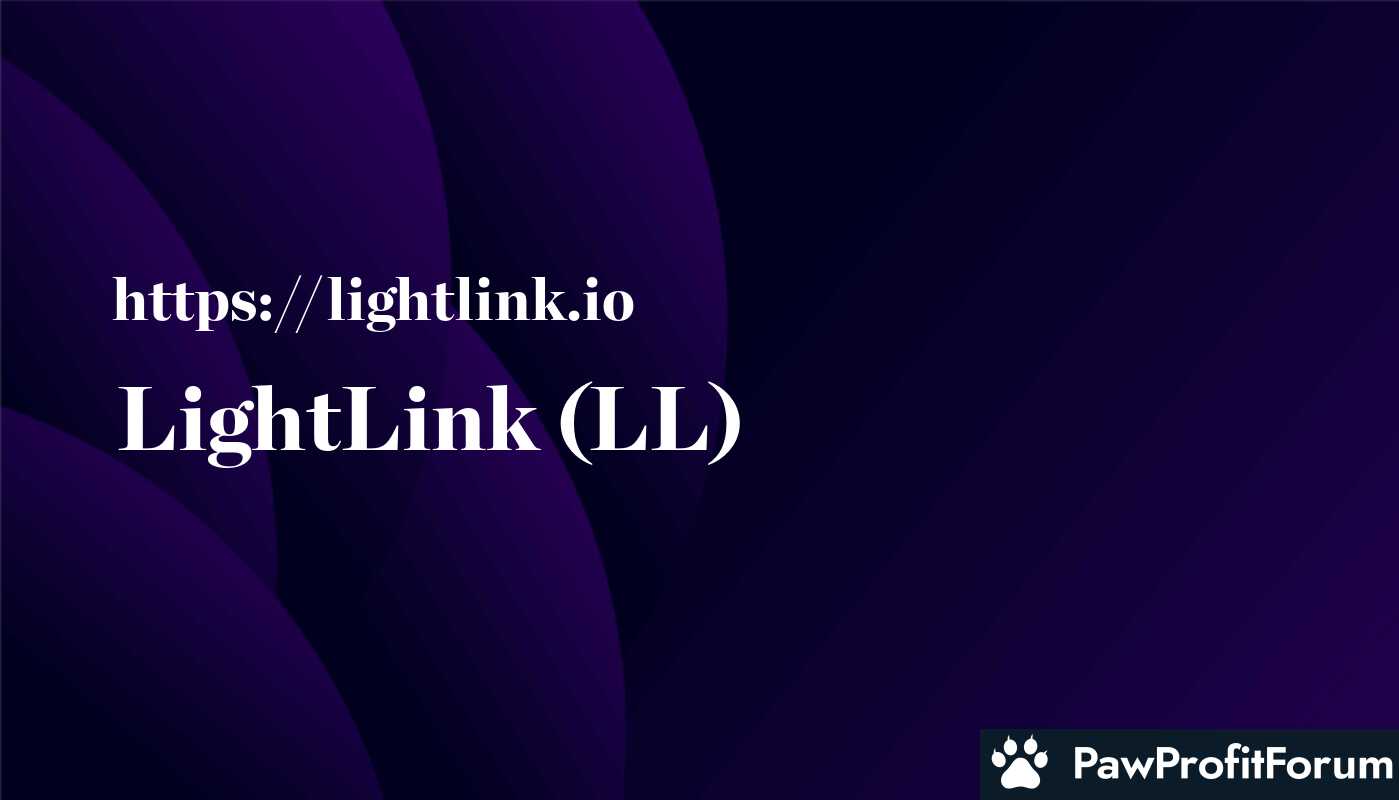LightLink is an Ethereum Layer 2 blockchain that lets dApps and enterprises offer users instant, gasless transactions.
LightLink's novel Enterprise Mode enables businesses to operate gas-free, allowing users on their platforms to engage in a secure, user-friendly blockchain network without transaction fees, barriers to entry, or the need for any tokens.
A distinctive feature of LightLink is its Enterprise Mode, which allows businesses to operate without gas fees. This mode facilitates a seamless and cost-effective blockchain environment, removing barriers to entry and eliminating the need for tokens. This is particularly beneficial for enterprises looking to integrate blockchain technology without imposing additional costs on their users.
LightLink's integration into Translucia and partnerships with Animoca Brands highlight its growing ecosystem and collaborative efforts. The LightLink Foundation plays a crucial role in supporting the blockchain's development, working with various partners to drive innovation and create a positive impact.
The blockchain employs the Geth codebase and utilizes Solidity for smart contract programming, ensuring compatibility and ease of development for developers familiar with the Ethereum ecosystem. This technical foundation supports a robust and scalable infrastructure, making LightLink a compelling choice for both developers and enterprises.
One of the standout features of LightLink is its ability to achieve over 10,000 transactions per second (TPS) while maintaining transaction costs under $0.01. This is made possible through a proprietary stack and the use of Celestia, a modular blockchain network that provides data availability and consensus. By integrating Celestia, LightLink ensures that the data required for validating transactions is always accessible, which is crucial for maintaining the integrity and security of the network.
Security is a paramount concern for any blockchain, and LightLink addresses this through several mechanisms. The use of Ethereum Optimistic Rollups plays a critical role here. These rollups assume transactions are valid by default but allow for a challenge period during which any incorrect transactions can be disputed and corrected. This mechanism helps prevent fraudulent activities and ensures that the network remains secure against bad actors.
In addition to its technical prowess, LightLink employs the Geth codebase, which is the most widely used implementation of the Ethereum protocol. This compatibility allows developers to use Solidity, Ethereum's programming language for smart contracts, making it easier to port existing Ethereum dApps to LightLink without significant modifications. This seamless integration with existing Ethereum tools and infrastructure is a significant advantage for developers looking to leverage LightLink's enhanced performance and lower costs.
LightLink also introduces a novel feature called Enterprise Mode, which is particularly beneficial for businesses. This mode enables gas-free transactions, allowing enterprises to operate on the blockchain without incurring transaction fees. This feature removes a significant barrier to entry, making blockchain technology more accessible and user-friendly for both businesses and their customers. Users can interact with the blockchain without needing to hold any tokens, simplifying the user experience and broadening the potential user base.
The integration of LightLink into Translucia, a US$300 million venture by T&B Media Global, underscores its practical applications and potential for large-scale adoption. This partnership highlights LightLink's capability to support substantial projects and its readiness for real-world implementation.
LightLink's architecture is designed to prevent attacks and ensure network stability. By utilizing Ethereum Optimistic Rollups and Celestia's data availability layer, LightLink creates a resilient environment where transactions are processed efficiently and securely. The challenge period in Optimistic Rollups acts as a safeguard against fraudulent transactions, while Celestia ensures that all necessary data is available for verification.
The combination of high transaction throughput, low costs, and robust security measures makes LightLink a compelling choice for developers and enterprises alike. Its compatibility with Ethereum's existing ecosystem, coupled with innovative features like gasless transactions and Enterprise Mode, positions LightLink as a forward-thinking solution in the blockchain space.
A significant application of LightLink is its Enterprise Mode, which allows businesses to operate gas-free. This feature is crucial for companies looking to integrate blockchain technology without imposing additional costs on their users. By eliminating transaction fees, businesses can offer a seamless and cost-effective experience, encouraging wider adoption of blockchain solutions.
LightLink supports over 10,000 transactions per second (TPS) at a cost of under $0.01, making it highly scalable and efficient. This capability is essential for applications requiring high throughput, such as gaming, finance, and public transport. For instance, in the gaming industry, LightLink can handle numerous in-game transactions quickly and affordably, enhancing the overall gaming experience.
Interoperability is another key aspect of LightLink. It is compatible with the Ethereum Virtual Machine (EVM), allowing developers to write smart contracts in Visual Studio Code and interact with LightLink using familiar tools. This compatibility ensures that existing Ethereum developers can easily transition to or integrate with LightLink, fostering innovation and collaboration within the blockchain community.
LightLink is also making strides in the enterprise sector through its integration with Translucia, a US$300 million venture by T&B Media Global. This partnership highlights LightLink's potential to support large-scale projects and ventures, demonstrating its real-world applicability and impact.
The LightLink Foundation plays a pivotal role in supporting blockchain projects by providing resources and expertise for growth and collaboration. This initiative helps nurture new projects and ideas, contributing to the broader blockchain ecosystem.
In summary, LightLink's applications span various industries, including gaming, finance, and enterprise solutions, offering a scalable, cost-effective, and user-friendly blockchain experience.
In January 2023, LightLink launched its private Mainnet, marking a significant milestone in its development. This launch set the stage for subsequent advancements and integrations within the blockchain ecosystem. Following this, LightLink introduced its Testnet and Mainnet Bridges, facilitating seamless interoperability and enhancing the network's functionality.
A notable collaboration emerged with Animoca Brands and T&B Media Global, highlighting LightLink's commitment to strategic partnerships. These alliances aim to leverage blockchain technology to drive innovation and adoption across various sectors.
LightLink's Token Generation Event (TGE) is scheduled for April 24, 2024. This event is pivotal as it marks the official distribution of LL tokens, which are integral to the network's operations and governance. On the same day, LL will be listed on KuCoin, expanding its accessibility to a broader audience and enhancing liquidity.
To foster development and innovation, LightLink has initiated an ongoing hackathon. This event encourages developers to build on the LightLink network, offering a platform for creativity and technological advancement. Additionally, LightLink provides grants and technical assistance to projects that align with its mission, further supporting the growth of its ecosystem.
The token distribution and vesting schedule are crucial components of LightLink's strategy, ensuring a structured and transparent allocation of LL tokens. This approach aims to maintain stability and incentivize long-term participation within the network.
LightLink's commitment to supporting and accelerating projects is evident through its grant programs and technical assistance offerings. These initiatives are designed to nurture innovation and align with the network's overarching goals.
Through these key events and strategic initiatives, LightLink continues to solidify its position within the blockchain and cryptocurrency landscape, driving forward its mission of enabling gasless, instant transactions for dApps and enterprises.
LightLink's novel Enterprise Mode enables businesses to operate gas-free, allowing users on their platforms to engage in a secure, user-friendly blockchain network without transaction fees, barriers to entry, or the need for any tokens.
What is LightLink?
LightLink (LL) stands out as an Ethereum Layer 2 blockchain designed to revolutionize transaction efficiency and cost. By leveraging Ethereum Optimistic Rollups, LightLink enables instant, gasless transactions, supporting over 10,000 transactions per second (TPS) at a cost of under $0.01. This makes it an attractive option for decentralized applications (dApps) and enterprises seeking to minimize transaction fees and enhance user experience.A distinctive feature of LightLink is its Enterprise Mode, which allows businesses to operate without gas fees. This mode facilitates a seamless and cost-effective blockchain environment, removing barriers to entry and eliminating the need for tokens. This is particularly beneficial for enterprises looking to integrate blockchain technology without imposing additional costs on their users.
LightLink's integration into Translucia and partnerships with Animoca Brands highlight its growing ecosystem and collaborative efforts. The LightLink Foundation plays a crucial role in supporting the blockchain's development, working with various partners to drive innovation and create a positive impact.
The blockchain employs the Geth codebase and utilizes Solidity for smart contract programming, ensuring compatibility and ease of development for developers familiar with the Ethereum ecosystem. This technical foundation supports a robust and scalable infrastructure, making LightLink a compelling choice for both developers and enterprises.
What is the technology behind LightLink?
LightLink (LL) represents a significant advancement in blockchain technology, offering a robust and efficient platform for decentralized applications (dApps) and enterprises. At its core, LightLink is an Ethereum Layer 2 blockchain, which means it builds on top of the Ethereum network to enhance its capabilities. This Layer 2 solution leverages Ethereum Optimistic Rollups, a technology that bundles multiple transactions into a single batch, reducing the load on the main Ethereum chain and significantly increasing transaction throughput.One of the standout features of LightLink is its ability to achieve over 10,000 transactions per second (TPS) while maintaining transaction costs under $0.01. This is made possible through a proprietary stack and the use of Celestia, a modular blockchain network that provides data availability and consensus. By integrating Celestia, LightLink ensures that the data required for validating transactions is always accessible, which is crucial for maintaining the integrity and security of the network.
Security is a paramount concern for any blockchain, and LightLink addresses this through several mechanisms. The use of Ethereum Optimistic Rollups plays a critical role here. These rollups assume transactions are valid by default but allow for a challenge period during which any incorrect transactions can be disputed and corrected. This mechanism helps prevent fraudulent activities and ensures that the network remains secure against bad actors.
In addition to its technical prowess, LightLink employs the Geth codebase, which is the most widely used implementation of the Ethereum protocol. This compatibility allows developers to use Solidity, Ethereum's programming language for smart contracts, making it easier to port existing Ethereum dApps to LightLink without significant modifications. This seamless integration with existing Ethereum tools and infrastructure is a significant advantage for developers looking to leverage LightLink's enhanced performance and lower costs.
LightLink also introduces a novel feature called Enterprise Mode, which is particularly beneficial for businesses. This mode enables gas-free transactions, allowing enterprises to operate on the blockchain without incurring transaction fees. This feature removes a significant barrier to entry, making blockchain technology more accessible and user-friendly for both businesses and their customers. Users can interact with the blockchain without needing to hold any tokens, simplifying the user experience and broadening the potential user base.
The integration of LightLink into Translucia, a US$300 million venture by T&B Media Global, underscores its practical applications and potential for large-scale adoption. This partnership highlights LightLink's capability to support substantial projects and its readiness for real-world implementation.
LightLink's architecture is designed to prevent attacks and ensure network stability. By utilizing Ethereum Optimistic Rollups and Celestia's data availability layer, LightLink creates a resilient environment where transactions are processed efficiently and securely. The challenge period in Optimistic Rollups acts as a safeguard against fraudulent transactions, while Celestia ensures that all necessary data is available for verification.
The combination of high transaction throughput, low costs, and robust security measures makes LightLink a compelling choice for developers and enterprises alike. Its compatibility with Ethereum's existing ecosystem, coupled with innovative features like gasless transactions and Enterprise Mode, positions LightLink as a forward-thinking solution in the blockchain space.
What are the real-world applications of LightLink?
LightLink (LL) is an Ethereum Layer 2 blockchain designed to enhance the user experience and scalability of Ethereum-based applications. One of its standout features is the ability to facilitate instant, gasless transactions, which is particularly beneficial for decentralized applications (dApps) and enterprises. This means users can interact with the blockchain without worrying about transaction fees, making it more accessible and user-friendly.A significant application of LightLink is its Enterprise Mode, which allows businesses to operate gas-free. This feature is crucial for companies looking to integrate blockchain technology without imposing additional costs on their users. By eliminating transaction fees, businesses can offer a seamless and cost-effective experience, encouraging wider adoption of blockchain solutions.
LightLink supports over 10,000 transactions per second (TPS) at a cost of under $0.01, making it highly scalable and efficient. This capability is essential for applications requiring high throughput, such as gaming, finance, and public transport. For instance, in the gaming industry, LightLink can handle numerous in-game transactions quickly and affordably, enhancing the overall gaming experience.
Interoperability is another key aspect of LightLink. It is compatible with the Ethereum Virtual Machine (EVM), allowing developers to write smart contracts in Visual Studio Code and interact with LightLink using familiar tools. This compatibility ensures that existing Ethereum developers can easily transition to or integrate with LightLink, fostering innovation and collaboration within the blockchain community.
LightLink is also making strides in the enterprise sector through its integration with Translucia, a US$300 million venture by T&B Media Global. This partnership highlights LightLink's potential to support large-scale projects and ventures, demonstrating its real-world applicability and impact.
The LightLink Foundation plays a pivotal role in supporting blockchain projects by providing resources and expertise for growth and collaboration. This initiative helps nurture new projects and ideas, contributing to the broader blockchain ecosystem.
In summary, LightLink's applications span various industries, including gaming, finance, and enterprise solutions, offering a scalable, cost-effective, and user-friendly blockchain experience.
What key events have there been for LightLink?
LightLink (LL) is an Ethereum Layer 2 blockchain designed to enable decentralized applications (dApps) and enterprises to offer users instant, gasless transactions. Its innovative Enterprise Mode allows businesses to operate without gas fees, providing a secure and user-friendly blockchain network.In January 2023, LightLink launched its private Mainnet, marking a significant milestone in its development. This launch set the stage for subsequent advancements and integrations within the blockchain ecosystem. Following this, LightLink introduced its Testnet and Mainnet Bridges, facilitating seamless interoperability and enhancing the network's functionality.
A notable collaboration emerged with Animoca Brands and T&B Media Global, highlighting LightLink's commitment to strategic partnerships. These alliances aim to leverage blockchain technology to drive innovation and adoption across various sectors.
LightLink's Token Generation Event (TGE) is scheduled for April 24, 2024. This event is pivotal as it marks the official distribution of LL tokens, which are integral to the network's operations and governance. On the same day, LL will be listed on KuCoin, expanding its accessibility to a broader audience and enhancing liquidity.
To foster development and innovation, LightLink has initiated an ongoing hackathon. This event encourages developers to build on the LightLink network, offering a platform for creativity and technological advancement. Additionally, LightLink provides grants and technical assistance to projects that align with its mission, further supporting the growth of its ecosystem.
The token distribution and vesting schedule are crucial components of LightLink's strategy, ensuring a structured and transparent allocation of LL tokens. This approach aims to maintain stability and incentivize long-term participation within the network.
LightLink's commitment to supporting and accelerating projects is evident through its grant programs and technical assistance offerings. These initiatives are designed to nurture innovation and align with the network's overarching goals.
Through these key events and strategic initiatives, LightLink continues to solidify its position within the blockchain and cryptocurrency landscape, driving forward its mission of enabling gasless, instant transactions for dApps and enterprises.
Who are the founders of LightLink?
LightLink (LL) is an Ethereum Layer 2 blockchain designed to facilitate instant, gasless transactions for dApps and enterprises. The founders of LightLink are Roy Hui and Olivia Romero. Roy Hui, with a background in blockchain technology and software development, has played a pivotal role in the technical architecture and strategic direction of LightLink. Olivia Romero, known for her expertise in business development and blockchain integration, has been instrumental in fostering partnerships and expanding the platform's reach. Their combined efforts have enabled LightLink to offer a secure, user-friendly network with its novel Enterprise Mode, eliminating transaction fees and barriers to entry.| Website | lightlink.io |
| Website | docs.lightlink.io |
| Socials | twitter.com/LightLinkChain |
| Socials | github.com/lightlink-network |
| Socials | t.me/lightlinkLL |
| Contracts | 0x0921...29Dc73 |
| Explorers | etherscan.io/token/0x0921799CB1d702148131024d18fCdE022129Dc73 |



